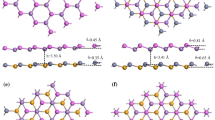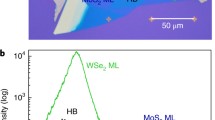Abstract
The structure and electronic properties of bilayer, trilayer, and multilayer vertical Janus heterostructures are studied by first-principles calculation. By comparing the electronic structure of monolayer SMoS, monolayer SeMoS, and SMoS/SeMoS heterostructures, it has been found that, when SMoS forms heterostructures with more than two layers of Janus SeMoS, the band gap of the system changes from direct to indirect. In the Janus heterostructure system, significant charge transfer occurs between layers and a certain built-in electric field occurs. Due to the different contribution of Mo-d orbital coupling to CBM in different SeMoS layers, the band gap oscillates periodically with three layers of SeMoS. As the number of SeMoS layers in the heterostructure increases, the electrostatic potential difference and built-in electric field of the system increases continuously, resulting in the band gap value decreasing slowly. At the same time, the valence band offset value of the heterostructure constructed by SMoS and multilayer SeMoS decreases, and the conduction band offset value increases. These properties enrich the research and application of transition metal dichalcogenide-related heterostructures as optoelectronic and nanoelectronic devices.







Similar content being viewed by others

References
M. Xu, T. Liang, M. Shi, and H. Chen, Graphene-like two-dimensional materials. Chem. Rev. 113, 3766 (2013).
M. Chhowalla, H.S. Shin, G. Eda, L.J. Li, K.P. Loh, and H. Zhang, The chemistry of two-dimensional layered transition metal dichalcogenide nanosheets. Nat. Chem. 5, 263 (2013).
H. Wang, H. Feng, and J. Li, Graphene and graphene-like layered transition metal dichalcogenides in energy conversion and storage. Small 10, 2165 (2014).
Q.H. Wang, K. Kalantar-Zadeh, A. Kis, J.N. Coleman, and M.S. Strano, Electronics and optoelectronics of two-dimensional transition metal dichalcogenides. Nat. Nanotechnol. 7, 699 (2012).
X. Chia, A.Y. Eng, A. Ambrosi, S.M. Tan, and M. Pumera, Electrochemistry of nanostructured layered transition-metal dichalcogenides. Chem. Rev. 115, 11941 (2015).
A.Y. Lu, H. Zhu, J. Xiao et al., Janus monolayers of transition metal dichalcogenides. Nat. Nanotechnol. 12, 744 (2017).
Y. Li, J.J. Wang, B.Z. Zhou, F. Wang, Y.P. Miao, J.Q. Wei, B.J. Zhang, and K.L. Zhang, Tunable interlayer coupling and Schottky barrier in graphene and Janus MoSSe heterostructures by applying an external field. Phys. Chem. Chem. Phys. 20, 24109 (2018).
X.S. Xiong, J. Zhang, C. Chen, S. Yang, J.C. Lin, J.H. Zeng, J.H. Xi, Z. Kong, and Y.J. Yuan, Facile fabrication of atom-level heterojunction 2D SeMoS nanoplates with excellent performance in photoelectrochemistry and photocatalytic levofloxacin degradation. J. Alloy. Compd. 911, 165073 (2022).
K.F. Mak and J. Shan, Photonics and optoelectronics of 2D semiconductor transition metal dichalcogenides. Nat. Photonics 10, 216 (2016).
C. Luo, X. Peng, J. Qu, and J. Zhong, Valley degree of freedom in ferromagnetic Janus monolayer H-VSSe and the asymmetry-based tuning of the valleytronic properties. Phys. Rev. B 101, 245416 (2020).
K.S. Novoselov, A. Mishchenko, A. Carvalho, and A.H. Castro, Neto, 2D materials and van der Waals heterostructures. Science 353, 9439 (2016).
J. Azadmanjiri, V.K. Srivastava, P. Kumar, Z. Sofer, J.K. Min, and J. Gong, Graphene-supported 2D transition metal dichalcogenide van der waals heterostructures. Appl. Mater. Today 19, 100600 (2020).
A.K. Geim and I.V. Grigorieva, Van der Waals heterostructures. Nature 499, 419 (2013).
B. Amin, N. Singh, and U. Schwingenschlögl, Heterostructures of transition metal dichalcogenides. Phys. Rev. B 92, 075439 (2015).
F. Li, W. Wei, P. Zhao, B. Huang, and Y. Dai, The experimental measurement of local and bulk oxygen transport resistances in the catalyst layer of proton exchange membrane fuel cells. J. Phys. Chem. Lett. 8, 5848 (2017).
X.S. Xiong, J. Zhang, C. Chen, S. Yang, J.C. Lin, J.H. Xi, and Z. Kong, Novel n-SeMoS/p-Co3O4 Z-scheme heterojunction photocatalyst for highly boosting photoelectrochemical and photocatalytic activity. J. Alloy. Compd. 926, 166863 (2022).
X. Xiong, J. Zhang, C. Chen, et al. Novel 0D/2D Bi2WO6/SeMoS Z-scheme heterojunction for enhanced photocatalytic degradation and photoelectrochemical activity. Ceram. Int. 48, 31970 (2022)
X. Xiong, H. Yang, J. Zhang et al., Novel SeMoS/Bi2WO6 S-scheme heterojunction photocatalysts for significantly improved photoelectrochemical and photocatalytic performance. J. Alloy. Compd. 933, 167784 (2023).
W.Z. Zhou, J.Y. Chen, Z.X. Yang, J.W. Liu, and F.P. Ouyang, Geometry and electronic structure of monolayer, bilayer, and multilayer Janus WSSe. Phys. Rev. B 99, 075160 (2019).
S. Liu, J.N. Fry, and H.P. Cheng, Multiple control of few-layer Janus MoSSe systems. Phys. Rev. Mater. 5, 064007 (2021).
C. Espejo, T. Rangel, A.H. Romero, X. Gonze, and G.M. Rignanese, Band structure tunability in MoS2 under interlayer compression: a DFT and GW study. Phys. Rev. B 87, 245114 (2013).
W. Li, A.B. Posadas, and A.A. Demkov, Band offset modulation in Si-EuO heterostructures via controlled interface formation. Phys. Rev. B 100, 155303 (2019).
T.L. Kim, M.J. Choi, T.H. Lee, W. Sohn, and H.W. Jang, Tailoring of interfacial band offsets by an atomically thin polar insulating layer to enhance the water-splitting performance of oxide heterojunction photoanodes. Nano. Lett. 19, 5897 (2019).
G. Kresse and D. Joubert, From ultrasoft pseudopotentials to the projector augmented-wave method. Phys. Rev. B 59, 1758 (1999).
J.P. Perdew, K. Burke, and M. Ernzerhof, Generalized gradient approximation made simple. Phys. Rev. Lett. 77, 3865 (1996).
G. Kresse and J. Furthmuller, Efficient iterative schemes for ab initio total-energy calculations using a plane-wave basis set. Phys. Rev. B 54, 11169 (1996).
Z. Nourdine and P. Pier, Transition-metal dichalcogenide bilayers: switching materials for spintronic and valleytronic applications. Phys. Rev. B 90, 125440 (2014).
H.-P. Komsa and A.V. Krasheninnikov, Electronic structures and optical properties of realistic transition metal dichalcogenide heterostructures from first principles. Phys. Rev. B 88, 085318 (2013).
S. Yu, S.J. Ran, H. Zhu, K. Eshun, C. Shi, K. Jiang, K.M. Gu, F.J. Seo, and Q.L. Li, Study of interfacial strain at the α-Al2O3/monolayer MoS2 interface by first principle calculations. Appl. Surf. Sci. 428, 593 (2018).
K. Kośmider and R. Fernández, Electronic properties of the MoS2-WS2 heterojunction. Phys. Rev. B 87, 075451 (2013).
Y. Ji, M. Yang, H. Lin, T. Hou, L. Wang, Y. Li, and S.-T. Lee, Janus structures of transition metal dichalcogenides as the heterojunction photocatalysts for water splitting. J. Phys. Chem. C 122, 3123 (2018).
H.T. Liu, Z.Y. Huang, C.Y. He, Y.B. Wu, L. Xue, C. Tang, X. Qi, and J.X. Zhong, Strain engineering the structures and electronic properties of Janus monolayer transition-metal dichalcogenides. J. Appl. Phys. 125, 082516 (2019).
H.T. Liu, Z.Y. Huang, P. Wu, W.M. Xue, C.Y. He, X. Qi, and J.X. Zhong, Band offsets engineering in asymmetric Janus bilayer transition-metal dichalcogenides. J. Phys. Condens. Mat. 32, 035502 (2019).
Z. Jia, H. Zhang, X.H. Chen, and W. Ding, First-principles study of lattice thermal conductivity in Janus SeMoS bilayers with different stacking modes. J. Electron. Mater. 52, 2458 (2023).
K. Zhang, Y. Guo, Q. Ji et al., Enhancement of van der Waals interlayer coupling through polar Janus MoSSe. J. Am. Chem. Soc. 142, 17499 (2020).
E. Cappelluti, R. Roldan, J.A. Silva-Guillen, P. Ordejon, and F. Guinea, Tight-binding model and direct-gap/indirect-gap transition in single-layer and multilayer SMoS. Phys. Rev. B 88, 075409 (2013).
Z.Y. Guan, S. Ni, and S.L. Hu, Tunable electronic and optical properties of monolayer and multilayer Janus SeMoS as a photocatalyst for solar water splitting: a first-principles study. J. Phys. Chem. C 122, 6209 (2018).
M. Mohammadi and E. Pakizeh, Electronic structure, optical properties, and potential applications of n-BN/WS2 (n = 1 to 4) heterostructures. J. Electron. Mater. 50, 4696 (2021).
Acknowledgments
This work is supported by the Grants from National Key R&D Program of the MOST of China (No. 2022YFA1602602), Provincial Natural Science Foundation of Hunan (No. 2022JJ30553), Scientific Research Fund of Hunan Provincial Education Department (Nos. 21A0080, 21B0128), and National Natural Science Foundation of China (No 12274359), Hunan Key Laboratory of Two-Dimensional Materials (No. 2018TP1010), and Research Project of Wuhan Polytechnic University (No. 2023Y38).
Author information
Authors and Affiliations
Corresponding authors
Ethics declarations
Conflict of interest
We declare that we have no financial and personal relationships with other people or organizations that can inappropriately influence our work, there is no professional or other personal interest of any nature or kind in any product, service and/or company that could be construed as influencing the position presented in, or the review of, the manuscript entitled.
Additional information
Publisher's Note
Springer Nature remains neutral with regard to jurisdictional claims in published maps and institutional affiliations.
Rights and permissions
Springer Nature or its licensor (e.g. a society or other partner) holds exclusive rights to this article under a publishing agreement with the author(s) or other rightsholder(s); author self-archiving of the accepted manuscript version of this article is solely governed by the terms of such publishing agreement and applicable law.
About this article
Cite this article
Liu, H., Huang, Z., Zhang, S. et al. Tunable Electronic Structure Oscillations on Layer-Dependent Multilayer Janus Heterostructures. J. Electron. Mater. 52, 5955–5963 (2023). https://doi.org/10.1007/s11664-023-10523-6
Received:
Accepted:
Published:
Issue Date:
DOI: https://doi.org/10.1007/s11664-023-10523-6



